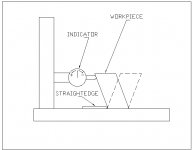ballen
Diamond
- Joined
- Sep 25, 2011
- Location
- Garbsen, Germany
I bought a surface grinder (150 x 450mm, chuck same size) this past summer and am learning to use it. One suggestion was to get a right-angle plate and make a grid of threaded holes on it, for holding parts. I just got this plate cheap, it's 80 x 100 x 100mm (3 x 4 x 4 inches). What grid spacing and thread are advisable? Should I mill off the diagonal ribs to get better clearance and to be able to use both faces? I have some precision 1/2/3 blocks that I can use to hold this to surface grind the faces.



Cheers,
Bruce
Cheers,
Bruce



 .
.
